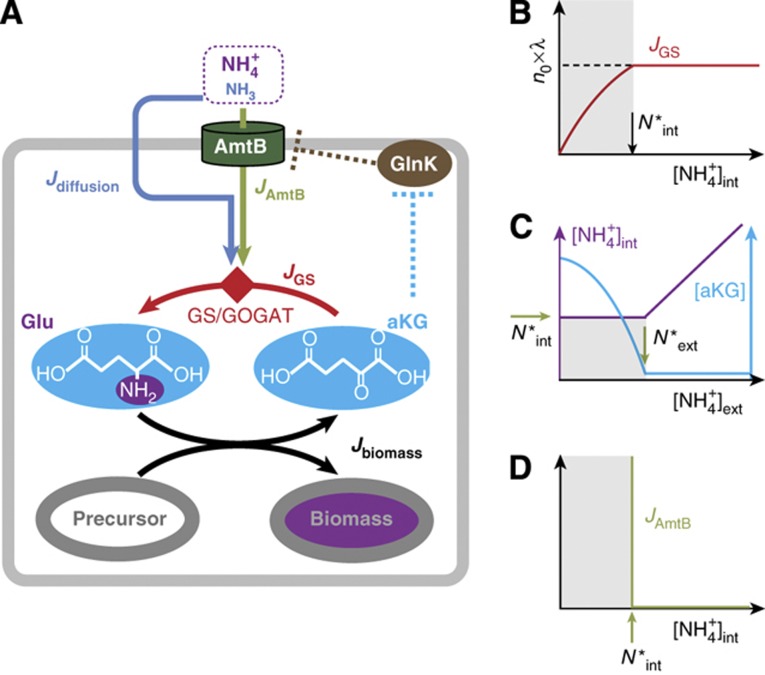Figure 5.
The integral feedback model of AmtB activation control. (A) Intracellular ammonium is assimilated into the biomass in two steps: first, it is captured in the form of glutamate (Glu) using the carbon skeleton α-ketoglutarate (aKG) via the GS/GOGAT pathway; see Supplementary Figure 3 for details. Then, the N-group in Glu is transferred to various carbon precursors to synthesize amino acids and incorporated into the biomass, while recycling the carbon skeleton back to aKG. Importantly, the aKG pool, which integrates imbalances between the ammonium assimilation flux (JGS) and the biomass incorporation flux (Jbiomass) (Equation (6)), is known to activate AmtB strongly (Gruswitz et al, 2007; Radchenko et al, 2010; Truan et al, 2010) via the regulatory GlnK (Coutts et al, 2002; Blauwkamp and Ninfa, 2003; Javelle et al, 2004), as indicated by the dashed cyan and brown lines. These interactions form the integral feedback loop (Equations (6), (7) and (8)). (B) The flux of ammonium assimilation by GS, JGS, plotted against the internal ammonium concentration, [NH4+]int. JGS is obtained from λ × n0, based on the form of  shown in Figure 2C. JGS decreases when [NH4+]int decreases below a certain level, N*int (gray region). (C, D) The steady-state aKG concentration ([aKG], cyan), internal ammonium concentration (purple), and AmtB activity (JAmtB, green) are deduced from Equation (8); see Supplementary Figure 4 for detailed explanation. N*ext is the external ammonium concentration ([NH4+]ext) below which JGS decreases without AmtB. For [NH4+]ext > N*ext, [aKG] remains at its basal level, and [NH4+]ext changes linearly with [NH4+]ext. For [NH4+]ext<N*ext, [aKG] increases and activates AmtB to the level needed to uphold [NH4+]int at N*int.
shown in Figure 2C. JGS decreases when [NH4+]int decreases below a certain level, N*int (gray region). (C, D) The steady-state aKG concentration ([aKG], cyan), internal ammonium concentration (purple), and AmtB activity (JAmtB, green) are deduced from Equation (8); see Supplementary Figure 4 for detailed explanation. N*ext is the external ammonium concentration ([NH4+]ext) below which JGS decreases without AmtB. For [NH4+]ext > N*ext, [aKG] remains at its basal level, and [NH4+]ext changes linearly with [NH4+]ext. For [NH4+]ext<N*ext, [aKG] increases and activates AmtB to the level needed to uphold [NH4+]int at N*int.

